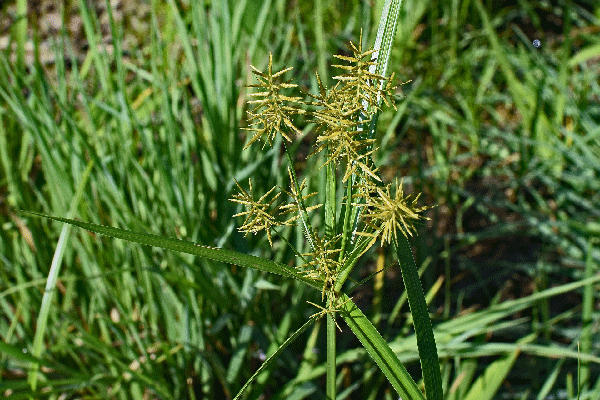About this time every summer weeds begin to drive us crazy; they love the heat of mid-summer! Here are some tips to help maintain your sanity and create the best long-term strategy to minimize weeds in your landscape.
Even though weeds are most problematic now, this is one of the worst times of year to get good control. Weeds don’t translocate herbicides into their roots well at this time of year, which limits effectiveness. In mid summer when a systemic herbicide is used, it often kills only the weeds leaves, but not the crown or roots. So they quickly recover and grow back.
There are four main weed groups - summer annuals, winter annuals, perennial broadleaf weeds and, in a class of its own, yellow nutsedge. Each has specific timing, strategies and methods to follow for the fewest headaches on your part and the best control. We'll discuss them below in the order you should use to attack them from now through fall.
Yellow Nutsedge Control
Long term control of this weed is difficult for two reasons. First, each plant is perennial – it will grow back for many years if not killed. Secondly, each develops multiple little tubers on its root system, as many as 15 per plant, so if you kill the original parent plant several of the dormant tubers will grow back in its place. Where you had one plant, now you have 5.
The best strategy is to kill the new young plants before they have matured enough to develop tubers on their roots. Yellow nutsedge responds to day length; plants are triggered by long days to begin forming tubers. This year the longest day is June 21, so mature yellow nutsedge plants will soon begin forming new tubers.
After June 21st, many gardeners are told it’s too late to control nutsedge, but that’s not true. You can still kill individual plants, but realize those mature plants have already formed tubers. When you kill the original parent plant, several new young plants will take its place. Don’t think one application of herbicide will end the problem; continue to make additional applications whenever new plants emerge and kill them before these new young plants can form their own tubers. Eventually repeated applications will provide control. Sedgehammer is the most effective product and is available at many garden centers.
Sedge Ender, made by Bonide, is another good nutsedge control product. It contains sulfentrazone which provides some pre-emergence control of the dormant tubers. When they start to germinate and grow, the chemical kills them. Again, you should be able to find this at garden centers with a good chemical selection.
Gardeners can use both Sedgehammer and Sedge Ender together. Hit the existing plants first with Sedgehammer to kill them. Then apply an application of Sedge Ender to kill tubers that might begin germinating. Plan to work at controlling this weed for several years, so you won't be discouraged. Just keep going after them.
If you don't want to use herbicides, you can achieve the same goal by hand-pulling plants. Just make sure you are consistently killing new plants as soon as they emerge, before they have time to develop new tubers. Eventually you will reduce the number of tubers in the soil and the problem will decrease. Repeated applications and consistency are the keys to long term control.
 Yellow woodsorrel is a common annual landscape weed. Image by John Fech, Nebraska Extension.
Yellow woodsorrel is a common annual landscape weed. Image by John Fech, Nebraska Extension.Summer Annual Weed Control
Preemergent herbicides are commonly applied in spring to kill weed seeds as they germinate, targeting common annual weeds such as crabgrass, foxtail, knotweed and spurge. Typically, the spring application is made in the last week of April or first week of May.
However, weed seed doesn’t just germinate in spring, it continues to germinate all summer long. A second application is necessary in mid-summer to provide continued weed control after your spring preemergent is gone.
Each preemergent herbicide has a specific residual period based on the active ingredient and product formulation. Time your second application based on the product you used.
- Prodiamine (Barricade) – 16 weeks
- Dithipyr (Dimension) – 9 weeks
- Pendimethalin (Pendulum) – 8 weeks
Do not apply more than the maximum seasonal rate of any preemergent herbicide, as specified on the product label. Fall control of annual weeds is unnecessary and wasteful. These weeds only live for one summer and naturally die in fall.
Lifecycle of Perennial, Biennial and Winter Annual Weeds
Fall is the best time of year to control perennial, biennial and winter annual weeds. Did you have pretty purple blooming henbit back in March and April? Or dandelions that popped out with the first warm days in May? Fall is the best time of year to control troublesome weeds for several reasons.
- Perennial weeds, like dandelions, ground ivy, poison ivy, field bindweed, curly dock and Canada thistle, begin moving carbohydrates from the leaves down to the roots for winter storage. If herbicides are applied in fall, they are transported to the roots along with the carbohydrates killing the entire plant instead of just the leaves. And even if the chemical doesn't completely kill the weed, the plant goes into winter in a weakened condition and is much more susceptible to winter kill.
- Biennial weeds, like musk thistle, grow into a small flat rosette of foliage their first year of growth. These rosettes are the ideal stage for herbicide control in fall.
- Winter annual weeds, such as henbit, marestail and the mustards (field pennycress, shepherds purse, tansy mustard, blue Mustard, etc.) germinate in the fall, overwinter as a small rosette of foliage, and begin growing again very early next spring. In fall they can be killed as they germinate with pre-emergent herbicides or targeted as young plants with post emergent products.
Perennial & Biennial Weed Control
Start your control of perennial and biennial weeds in early September and continue through mid-October. Many products are available for broadleaf weed control. Look for products containing the active ingredients 2,4-D, carfentrazone, sulfentrazone, quinclorac or triclopyr. These products are selective and won't damage grass, but use them with caution in landscape beds since accidental spraying or spray drift can damage shrubs and ornamental plants. Quinclorac is particularly effective at controlling wild violets.
Consider adding a spreader-sticker to your tank mix for even better control. Spreader-stickers are additives that help the chemical you apply spread over the weed leaf surface and adhere to it better. When you're trying to control weeds with waxy leaf surfaces, like wild violets, a spreader-sticker is particularly helpful. Look for products like Earl May's Turbo Spreader Sticker.
When targeting difficult weeds, don't expect 100% control with one herbicide application. Two or three herbicide applications, 2-3 weeks apart will usually be necessary to control them. Make your first application and, if in 2-3 weeks there is regrowth or green leaves still remaining on the plants, make a second application.
After making the herbicide application, don't mow for 2-3 days to allow the plants to take in the chemical.
 Henbit is a creeping winter annual weed, blooming in early spring with pinkish-purple flowers.
Henbit is a creeping winter annual weed, blooming in early spring with pinkish-purple flowers. Winter Annual Weed Control
If winter annual weeds, such as henbit, chickweed, and annual bluegrass, are a problem in your buffalograss lawn, a fall pre-emergent herbicide application should be made in early September.
Barricade (prodiamine), Dimension (dithiopyr) and Pendulum (pendimethalin) are commonly available home-use pre-emergent products labeled for use in turf or landscape plantings. Check the product’s active ingredient statement on the front of the label for these chemicals to make sure you are using the correct herbicide.
If you miss the application of pre-emergent, then a post emergent application in mid-October will kill many newly germinated winter annual weeds and prevent them from becoming a problem next spring.
Identify Weeds First
Before applying any herbicide, know the weeds you are trying to control. Get help from your local garden center or Nebraska Extension office if you’re not sure.

